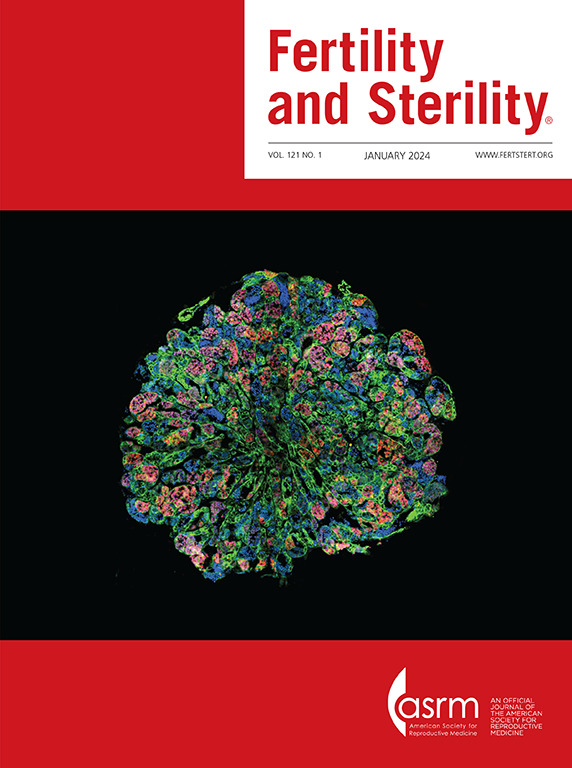青春期多囊卵巢综合征诊断的最新进展。
IF 7
1区 医学
Q1 OBSTETRICS & GYNECOLOGY
引用次数: 0
摘要
多囊卵巢综合征(PCOS)是一种常见的内分泌和代谢疾病,开始于青春期。国际循证指南和2023年的更新明确定义了青春期的诊断标准,目的是减少在这一关键生命阶段诊断的争议和挑战。在这篇叙述性的综述中,我们的目的是检查最近可用的数据与青春期多囊卵巢综合征的诊断。具体来说,我们评估了从2022年8月(最后一次搜索PCOS国际循证指南更新的日期)到2025年5月的出版物。目前的证据支持使用两种主要的青少年诊断标准:月经周期不规则,根据月经初潮后的时间明确定义,以及在排除其他类似多囊卵巢综合征的情况后,临床或生化的雄激素过多。与成人多囊卵巢综合征的诊断标准相反,盆腔超声多囊卵巢形态学和/或抗苗勒管激素水平不应用于青少年多囊卵巢综合征的诊断。青春期PCOS的准确和及时诊断有助于PCOS及其相关合并症的早期筛查和管理。同样重要的是早期识别被认为有多囊卵巢综合征“风险”的青少年(那些只符合一个诊断标准的人),因为新出现的证据表明代谢风险增加,并加强了长期随访的必要性。在定义明确的青少年队列中进行的新型聚类分析开始澄清诊断特征的阈值,并可能进一步完善青少年特异性标准。排除多囊卵巢形态和抗苗勒管激素的PCOS诊断标准;明确定义的不规则月经周期和高雄激素应在青春期应用。早期识别青少年多囊卵巢综合征和那些“有风险”的是至关重要的,以确保及时的代谢筛查和适当的随访。卫生保健专业人员应该意识到,不同的多囊性卵巢综合征的诊断标准是必要的青少年。本文章由计算机程序翻译,如有差异,请以英文原文为准。
Update on diagnosis of polycystic ovary syndrome during adolescence.
Polycystic ovary syndrome (PCOS) is a common endocrine and metabolic condition beginning during the peripubertal years. The international evidence-based guidelines and the update in 2023 have clearly defined the diagnostic criteria during adolescence with the goal of decreasing controversies and challenges with the diagnosis during this critical life stage. In this narrative review we aimed to examine the recent available data related to the diagnosis of PCOS during adolescence. Specifically, we evaluated publications from August 2022 (date when the last searches were run for the update of the international evidence-based guidelines on PCOS) to May 2025. Current evidence supports the use of two main diagnostic criteria for adolescents: irregular menstrual cycles, well defined according to time post-menarche, and hyperandrogenism, either clinical or biochemical, after excluding other conditions that mimic PCOS. In contrast to adult PCOS diagnostic criteria, polycystic ovary morphology on pelvic ultrasound and/or antimullerian hormone levels should not be used for adolescent PCOS diagnosis. Accurate and timely diagnosis of PCOS during adolescence enables early screening and management of PCOS and its associated comorbidities. Equally important is the early identification of adolescents considered "at risk" of PCOS (those who only meet one diagnostic criterion) as emerging evidence indicated increased metabolic risks and reinforces the need for long-term follow-up. Novel cluster analysis in well-defined adolescent cohorts is beginning to clarify threshold values for diagnostic features and may further refine adolescent-specific criteria. Specific PCOS diagnostic criteria avoiding polycystic ovary morphology and antimullerian hormone; and using of clearly defined irregular menstrual cycles and hyperandrogenism should be applied during adolescence. Early recognition of adolescents both with PCOS and those "at risk" is critical to ensure timely metabolic screening and appropriate follow-up. Health care professionals should be aware that different PCOS diagnostic criteria are necessary for adolescents.
求助全文
通过发布文献求助,成功后即可免费获取论文全文。
去求助
来源期刊

Fertility and sterility
医学-妇产科学
CiteScore
11.30
自引率
6.00%
发文量
1446
审稿时长
31 days
期刊介绍:
Fertility and Sterility® is an international journal for obstetricians, gynecologists, reproductive endocrinologists, urologists, basic scientists and others who treat and investigate problems of infertility and human reproductive disorders. The journal publishes juried original scientific articles in clinical and laboratory research relevant to reproductive endocrinology, urology, andrology, physiology, immunology, genetics, contraception, and menopause. Fertility and Sterility® encourages and supports meaningful basic and clinical research, and facilitates and promotes excellence in professional education, in the field of reproductive medicine.
 求助内容:
求助内容: 应助结果提醒方式:
应助结果提醒方式:


